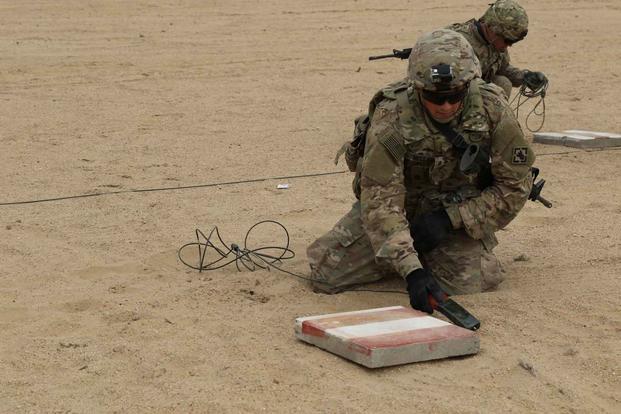The U.S. Army wants a deadly new networked land mine system that's more capable than current models at detecting enemy tanks and launching munitions that attack from above.
The Army's Project Manager Close Combat Systems, or PM CCS, is looking for defense firms that can produce Terrain Shaping Obstacle, or TSO, Top Attack prototypes, according to an April 12 sources-sought solicitation posted on the federal government's contracting website.
"The top attack system shall provide a lethal obstacle capability sufficient to [control] terrain by disrupting enemy maneuver and defeating threat forces," the document states.
Read Next: Sikorsky's S-97 Raider Recon Helicopter Performs First Flight Demos for Army Leaders
If successful, it would allow combat units to lay minefields that could be left in a standby mode for up to six months or ordered by remote control to go into a target engagement mode for up to 30 days, according to the document.
The Army's search for a deadlier anti-tank mine system is part of a larger effort by the service to prepare for a future war that could involve armored clashes with adversaries such as Russia and China.
Maneuver officials at Fort Benning, Georgia, announced April 8 that the service also wants to replace the venerable tube-launched, optically-tracked, wire-guided, or TOW, missile with an advanced projectile that can kill enemy tanks at ranges out to 10,000 meters.
The Army fielded the first TOW missile system in 1970. It was initially wire-guided, so soldiers had to remain stationary and vulnerable to the enemy as the missile tracked to the target. The current TOW, which has a range of about 3,750 meters, has a fire-and-forget operation.
The service wants the new top attack anti-tank mine system to consist of the Common Anti-Vehicle Munition top attack munition, the top attack Dispenser/Launcher Module, Remote Control Station and an obstacle planning capability, according to the solicitation.
The Common Anti-Vehicle Munition, or CAVM, will be designed to have "improved lethality" for destroying modern tank armor compared to previous generations of top attack munitions such as the M93 Hornet wide-area munition, the document states.
The M93, which was developed in the late 1980s, uses both seismic and acoustic sensors to track and identify potential targets near the mine. Once the mine detects a suitable target in range, the mine turns to face the target, elevates the submunition launcher and fires in the direction of the target. An infrared sensor on the submunition scans the ground for the target and triggers an explosively formed penetrator to attack the tank from the air.
The new system will feature a Remote Control Station, or RCS, that's capable of controlling at least 12 minefields -- each approximately 150 meters wide by 250 meters long -- from up to five kilometers away. Once emplaced, the Dispenser/Launcher Modules should be recoverable and reusable if they have not fired their top attack munitions, according to the solicitation.
The system is the first phase of the Close Terrain Shaping Obstacle, or CTSO, program, which PM CCS plans on starting to develop in the second quarter of fiscal 2022, according to the document. Phase two of the effort involves a bottom attack capability scheduled to begin in fiscal 2025 and a full-networked capability being planned to begin in fiscal 2026, it adds.
The top attack system should be compliant with the Pentagon-issued U.S. Landmine Policy and capable of displaying "SAFE and UNSAFE" authoritative safety information to the operator controlling the fields with a one-in-one million probability of false display of "safe," according to the document.
Interested companies have until May 14 to respond to the solicitation.
The Army plans to conduct a virtual industry event, set for April 27-29. The first day will be a general session, and the remaining two days will be reserved for one-on-one sessions between interested firms and the Army.
-- Matthew Cox can be reached at matthew.cox@military.com.
Related: Army Wants to Replace the Cold War-Era TOW Missile with a New Longer-Range Tank Killer














